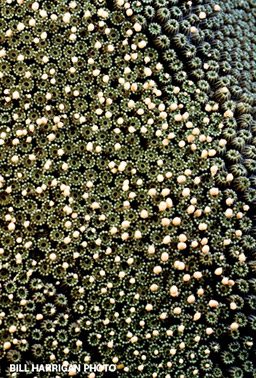If diving rewards you with the same sense of wonder that gets me back in the water dive after dive, you’re in for a treat this time of year. In the northern hemisphere, the late summer and early autumn months are prime time for a fascinating phenomenon called mass, or broadcast, spawning. In some cases, it’s also referred to as synchronized spawning.

When it’s time to mate, corals have a problem: one is here, and the other is way over there. Neither can move, but both are ready to make some little corals. The solution: Release eggs and sperm at the same time, and let them mingle in the water.
A good plan, but timing is critical. Something has to provide the “Get ready, go!” signal. Forget Jupiter aligning with Mars, but the Fifth Dimension did get it right when they sang, “When the moon is in the seventh house….” The get ready warning is dependent on the lunar cycle, with most spawning activity occurring in the six to eight days following a full moon. The go signal is triggered by local solar cycles with a little help from coral chemical releases and changes in water temperature. Even hermaphroditic corals follow these cosmic cues, releasing eggs and sperm simultaneously.
Coral spawning is only part of this fascinating story, though. Many other marine invertebrates engage in synchronized spawning, including starfish, brittle stars, fireworms, sea cucumbers, sponges and Christmas tree worms. Late summer and early fall are best for these, too, but it pays to keep your eyes open all year.
“You can see synchronized spawning on the reef almost any month,” said Ned DeLoach, editor of the popular Reef Coral, Reef Fish and Reef Creature Identification books, “but nearly always during that period of six to eight days after the full moon.”

Lad Akins, director of operations for the Reef Environment Education Foundation (REEF), said he’s also seen synchronized spawning year round, the coolest show put on by a little crustacean called an ostracod. Also known as sea fireflies, ostracod synchronize their spawning activities with a bioluminescent fireworks display. According to Akins, you can see it best by settling in the sand near a meadow of seagrass about 45 minutes after sunset on a waxing moon. The “halo” of sand around a patch reef is a good spot. Turn off your dive light and wait. If you’re in luck, you’ll see dozens of bioluminescent dots rising from the bottom as the males advertise their readiness to the females.
If night diving isn’t your thing, don’t be discouraged. I’ve seen brown sponges spawning in mid-afternoon in the Bahamas and Florida Keys. Akins has witnessed giant barrel sponges spawning during the day on Elbow Reef off Key Largo. “They look like volcanoes spewing a fine white smoke,” he said. “When one starts, they all start.”
So how do you spot spawning on your own dives? Check with the experts, and make a plan. Based on last year’s performance, the Bonaire National Marine Park has published on its website their 2010 mass spawning predictions for the southern Caribbean. For example, it’s predicted that boulder star coral will most likely spawn between 9:15 p.m. and 11 p.m. on Sept. 29 and 30. If you miss that window, there’s another chance during the same hours of Oct. 29 and 30. Further north in the Florida Keys, spawning is forecasted to follow the Aug. 24 full moon through the end of the month.
I also asked DeLoach for some tips. “Three things,” he said. “First, make your dives six, seven or eight days after the full moon; that will put you in the right time frame. Second, watch for anything unusual — starfish up on their ‘toes,’ for instance, or sea cucumbers rising up like cobras. Third, be prepared to spend a lot of time in the water.”
Don’t forget to bring your sense of wonder.
© Alert Diver — Q3 Summer 2010